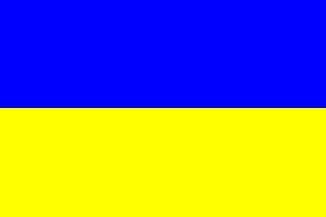![[Venhuizen new flag]](../images/n/nl-nh_vh.gif) by Jarig Bakker, 31 Oct 2003
by Jarig Bakker, 31 Oct 2003
adoption date unknown

Last modified: 2006-12-09 by jarig bakker
Keywords: venhuizen |
Links: FOTW homepage |
search |
disclaimer and copyright |
write us |
mirrors
![[Venhuizen new flag]](../images/n/nl-nh_vh.gif) by Jarig Bakker, 31 Oct 2003
by Jarig Bakker, 31 Oct 2003
adoption date unknown
 Shipmate Flagchart : http://www.flagchart.net
Shipmate Flagchart : http://www.flagchart.net
Flag: two equally wide horizontal stripes of blue and yellow.
This flag is not official, but was used by citizens and authorities.
The colors are derived from the municipal arms.
Source: Sierksma's Nederlands Vlaggenboek, 1962 [sie62].
![[Venhuizen CoA]](../images/n/nl-nh)vh.jpg) from "Gemeentewapens in"Nederland", 1989.
from "Gemeentewapens in"Nederland", 1989.
"In silver an eradicated branched dead treetrunk with two black stems in which five rising black crows with opened red beak and feet, the two on the left stem turned; in the treefork a blue escutcheon with a silver opened castle with three embattlements; in chief chequy lozenges of silver and blue; the shield surmontée with a golden crown of three leaves and two pearls."
Two of the three former municipalities had a dead tree on their arms.
In Schellinkhout were five birds in the branches, in Venhuizen three. This
dead tree occurs several times on West-Frisian arms, and is connected with
life afterwards. The CoA of Wijdenes had a castle on its arms, reminding
of the burgh built there by Roeland van Widelnisse at the orders of the
Count of Holland to curb the untuly West-Frisians. The burgh was demolished
by the Frisians after the death of Count Floris V and never rebuilt. The
tree with birds and the castle seemed both appropriate for the new CoA.
In addition it was thought to remind of the grant of city-rights to Schellinkhout,
Hem, and Venhuizen by the counts of Holland from the Bavarian house. Schellinkhout
became a city at the decision of Albrecht van Beieren in 1402; Hem and
Venhuizen in 1413 by the decision of Duke Willem II van Beieren (aka Count
Willem VI van Holland, Count Willem II of Henegouwen, and dad of Jacoba
van Beieren).
The main feature of the arms became the dead tree with five crows.
The tree received two stems on one stump to gave space to put the burgh
of Wijdenes on an escutcheon; the Bavarian involvement is represented in
the Bavarian colors and lozenges in chief. The crows were designed rising
and rasping to get a more pregnant silhouette. Beaks and legs were painted
red to get a livelier image. The burgh was made silver on a blue escutcheon.
The usual crown of three leaves and two pearls was added as ornament.
The arms were granted by Royal Resolution of 18 Nov 1970, No. 17.
Source: The Venhuizen municipal
website.
Jarig Bakker, 31 Oct 2003